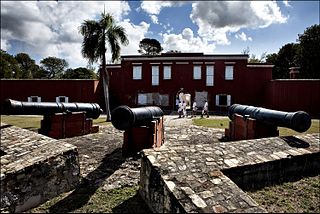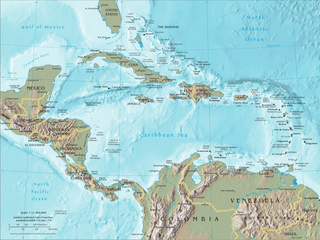
The United States Virgin Islands, officially the Virgin Islands of the United States, are a group of Caribbean islands and an unincorporated and organized territory of the United States. The islands are geographically part of the Virgin Islands archipelago and are located in the Leeward Islands of the Lesser Antilles.
Saint Croix is an island in the Caribbean Sea, and a county and constituent district of the United States Virgin Islands (USVI), an unincorporated territory of the United States.

Saint Thomas is one of the Virgin Islands in the Caribbean Sea, and a constituent district of the United States Virgin Islands (USVI), an unincorporated territory of the United States. Along with surrounding minor islands, it is one of three county-equivalents in the USVI. Together with Saint John, it forms one of the districts of the USVI. The territorial capital and port of Charlotte Amalie is located on the island.
The music of the Virgin Islands reflects long-standing West Indian cultural ties to the island nations to the south, the islands' African heritage and European colonial history, as well as recent North American influences. Though the United States Virgin Islands and British Virgin Islands are politically separate, they maintain close cultural ties. From its neighbors, the Virgin Islands has imported various pan-Caribbean genres of music, including calypso music and soca music from Trinidad and reggae from Jamaica.
The music of Montserrat is influenced by Irish traditions, noticeable in the set dance-like Bam-chick-lay, and the presence of fife and drum ensembles similar to the bodhrán. Natives are also witness to the jumbie dance, the style of which is still strongly African. Instruments include the ukulele and shak-shak, an African instrument made from a calabash gourd; both of these are used in traditional string bands. Calypso and spiritual-influenced vocal choirs, like the Emerald Isle Community Singers, are popular.

The music of Antigua and Barbuda is largely African in character, and has only felt a limited influence from European styles due to the population of Antigua and Barbuda descending mostly from West Africans who were made slaves by Europeans.

The Trinidad and Tobago Carnival is an annual event held on the Monday and Tuesday before Ash Wednesday in Trinidad and Tobago. This event is well known for participants' colorful costumes and exuberant celebrations. There are numerous cultural events such as "band launch" fetes running in the lead up to the street parade on Carnival Monday and Tuesday. Traditionally, the festival is associated with calypso music, developed by enslaved West and Central Africans in 17th century Trinidad; however, Soca music has begun to replace calypso as the more popular musical genre for Carnival. Costume, stick-fighting, limbo, and steelpan competitions are important components of the festival.

Frederiksted is both a town and one of the two administrative districts of St. Croix, U.S. Virgin Islands. It is a grid-planned city, designed by surveyor Jens Beckfor, originally to 14x14 blocks but built 7x7 to enhance the island commerce in the 1700s. Fewer than 1,000 people live in Frederiksted proper, but nearly 10,000 live on the greater western side of the island. Christiansted is about 30 years older, but commerce was limited by its natural, shallow protective reef. Frederiksted was built in the leeward side of the island for calm seas and a naturally deep port. It is home to Fort Frederik, constructed to protect the town from pirate raids and attacks from rival imperialist nations and named after Frederick V of Denmark, who purchased the Danish West Indies in 1754.
A jumbee, jumbie, mendo or chongo in Colombia and Venezuela is a type of mythological spirit or demon in the folklore of some Caribbean countries. Jumbee is the generic name given to all malevolent entities. There are numerous kinds of jumbees, reflecting the Caribbean's complex history and ethnic makeup, drawing on African, Amerindian, East Indian, Dutch, English, and even Chinese mythology.

The Antiguan Carnival is a celebration of emancipation from slavery, held annually on the island of Antigua. It is a thirteen-day festival of colorful costumes, beauty pageants, talent shows, and music. The festival begins in late July and ends the first Tuesday in August, known as Carnival Tuesday. Both Carnival Monday and Carnival Tuesday are public holidays on the island. Antiguan Carnival replaced the Old Time Christmas Festival in 1957, with hopes of inspiring tourism in Antigua and Barbuda. Some elements of the Old Time Christmas Festival remain in the modern Carnival celebrations.
The culture of St. Kitts and Nevis, two small Caribbean islands forming one country, has grown mainly out of the West African traditions of the slave population brought in during the colonial period. France and British colonists both settled the islands, and for a period of time the British imported indentured Irish servants. The native Caribs, skilled warriors, defended their lands by attacking the colonies. But by 1782, the British had gained control of St. Kitts and Nevis, which they retained until granting the islands their independence in 1983. British influence remains in the country's official language, English, while some islanders speak an English-based Creole. The influence of the French, Irish, and Carib seems less pronounced.
Virgin Islander culture reflects the various peoples that have inhabited the present-day British Virgin Islands and the U.S. Virgin Islands throughout history. Although the territories are politically separate, they maintain close cultural ties.
"Jumbie Jamberee" is a calypso song credited to Conrad Eugene Mauge, Jr. In 1953 Lord Intruder released the song as the B-side to "Disaster With Police". The song is also known as "Zombie Jamboree" and "Back to Back". The introduction to the Kingston Trio's version humorously credits "Lord Invader and his Twelve Penetrators" with authorship of the song instead of Lord Intruder.

The Caribbean is a subregion of the Americas that includes the Caribbean Sea and its islands, some of which are surrounded by the Caribbean Sea and some of which border both the Caribbean Sea and the North Atlantic Ocean; the nearby coastal areas on the mainland are sometimes also included in the region. The region is south-east of the Gulf of Mexico and Northern America, east of Central America, and north of South America.

The traditions of West Africa and the United Kingdom have the biggest impact on the culture of Antigua and Barbuda. As a crucial component of its culture, Antigua and Barbuda also has its own creole language.
Dennis Liburd, better known by his stage name Pumpa, is a Virgin Islands soca artist from St. Kitts.
Delta Dorsch was an educator, story-teller and preserver of the cultural history of the United States Virgin Islands. Teaching for 38 years, working with the Department of Education and the Commission on the Preservation of Virgin Islands Culture, Dorsch was a tireless advocate for conserving traditions of the Virgin Islands and teaching as a means of giving them life. She contributed two books on the history and traditions of the country and received many awards and honors in recognition of her work.

Virgin Islands – Puerto Rico Friendship Day is a public holiday celebrated in the U.S. Virgin Islands on the second Monday in October.

Tracey Baptiste is a children's horror author from the Caribbean who uses folk stories in her novels.











